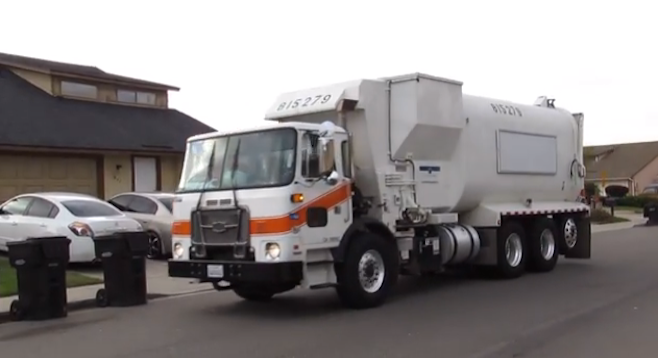 Facebook
Facebook
 X
X
 Instagram
Instagram
 TikTok
TikTok
 Youtube
Youtube

The Chargers' extended farewell to San Diego may be complete, but a local company claims in a study released this week the NFL poses an unlikely threat to Americans everywhere in the form of sleepy garbage truck drivers.
Lytx, a San Diego–based firm that provides analytical data on truck fleets through onboard cameras, says an examination of 33,000 garbage trucks over four years (2012-2016) shows a marked spike in incidents of drowsy driving or drivers falling asleep behind the wheel between August and November.
Last year, collisions and near-misses attributed to exhausted drivers rose 112 percent during the four-month period. On Mondays and Tuesdays, the danger of an incident was 170 percent greater than at other times during the year.
The company is attributing the higher accident rate to popular evening broadcasts by the NFL on nights preceding the highest-risk workdays. Even though these games end as early as 10 p.m. on the West Coast, other research has pointed to a strong link between football watching and alcohol consumption.
"Waste drivers have one of the toughest jobs in America, and on top of a strenuous work day, they tend to have very early shifts, heading out to make their rounds before the sun's come up," said Darrell Smith, National Waste and Recycling Association president and CEO in a release accompanying the findings. "Combine that with a late night of watching football, and the risk of drowsy driving is predictable — but solvable."
Lytx suggests employers try "encouraging their drivers to get more sleep on football nights" as a means of mitigating risk.


The Chargers' extended farewell to San Diego may be complete, but a local company claims in a study released this week the NFL poses an unlikely threat to Americans everywhere in the form of sleepy garbage truck drivers.
Lytx, a San Diego–based firm that provides analytical data on truck fleets through onboard cameras, says an examination of 33,000 garbage trucks over four years (2012-2016) shows a marked spike in incidents of drowsy driving or drivers falling asleep behind the wheel between August and November.
Last year, collisions and near-misses attributed to exhausted drivers rose 112 percent during the four-month period. On Mondays and Tuesdays, the danger of an incident was 170 percent greater than at other times during the year.
The company is attributing the higher accident rate to popular evening broadcasts by the NFL on nights preceding the highest-risk workdays. Even though these games end as early as 10 p.m. on the West Coast, other research has pointed to a strong link between football watching and alcohol consumption.
"Waste drivers have one of the toughest jobs in America, and on top of a strenuous work day, they tend to have very early shifts, heading out to make their rounds before the sun's come up," said Darrell Smith, National Waste and Recycling Association president and CEO in a release accompanying the findings. "Combine that with a late night of watching football, and the risk of drowsy driving is predictable — but solvable."
Lytx suggests employers try "encouraging their drivers to get more sleep on football nights" as a means of mitigating risk.
Comments